One of the fungal infections we most frequently encounter in clients’ gardens is Honey Fungus. It attacks the roots of woody plants causing rapid decline and ultimately death of the plant.
What is Honey Fungus?
Honey Fungus is the common name given to a number of species within the Armillaria family.
It is one of the most aggressive wood decaying pathogens to be found in gardens. The fungus attacks the roots and stems of plants causing dieback, rapid decline and death.
The infection is spread by the black root like ‘bootlaces’, or rhizomorphs, which grow through the surrounding soil to infect other species growing nearby.
How does Honey Fungus affect trees and shrubs?
Often the first sign of infection is when branches and foliage begins to dieback, or the plants leaves discolour or are noticeably smaller than usual. Such symptoms are an indicator of a failure in the root system through infection of the fungus.
In the latter stages of the infection cycle, honey coloured, or brown toadstools grow during autumn in clusters around the base of the tree or shrub. The toadstools will always have a collar growing on their stems.
Bark will often crack and die at the base of the stem and if it’s peeled back, you will find a creamy white sheet layer fungus growing, known as mycelium. This will smell of mushrooms and is often accompanied by rhizomorphs growing between the bark and plant tissue.
Control and Treatment
There is no chemical treatment available to control Honey Fungus.
Infected trees and shrubs should be removed and as much woody material i.e. stumps and roots, should also be removed from the site.
Once Honey Fungus is in the soil, it is incredibly difficult to eradicate it.
In order to reduce the chance of infection from Honey Fungus, it is important to try to reduce stress to trees and shrubs by maintaining nutrient levels, keeping watered where possible in times of drought and keeping them pest free.
Re-planting
When considering re-planting after removal of a tree, shrub or plant that has been killed by Honey Fungus refer to The Royal Horticultural Society, which details species that are susceptible to infection from Honey Fungus and those which may offer more resilience to infection.
When re-planting shrubs and plants, using butyl rubber pond liner to line planting holes can reduce the risk of infection by providing a physical barrier to the root system. We would not however recommend this method for the planting of tree species as it would interfere with root development and cause potential stability issues for the tree in future years.
What we can offer
Unfortunately, when Honey Fungus infects trees, it may well increase the risk of failure to that tree as the infection decays and kills the trees rooting system. This will render the tree unstable and would require tree removal in order to mitigate any risk to persons or property.
Should you have any concerns or require professional advice with regards to trees and shrubs in your gardens, then please contact us on 0800 975 4535 or send us a message.
Our Accreditations









